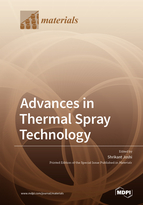Advances in Thermal Spray Technology
A special issue of Materials (ISSN 1996-1944). This special issue belongs to the section "Manufacturing Processes and Systems".
Deadline for manuscript submissions: closed (30 April 2020) | Viewed by 44931
Special Issue Editor
Interests: suspension and solution plasma spraying; HVAF spraying; thermal barrier coatings; coatings for wear and corrosion; additive manufacturing; electron beam melting; laser metal deposition; post-treatment
Special Issues, Collections and Topics in MDPI journals
Special Issue Information
Dear Colleagues,
Thermal spray technology is already widely adopted industrially to deposit different kinds of coatings (metallic, intermetallic, ceramic, and their combinations) for combating diverse forms of surface degradation caused by wear, corrosion, oxidation, high thermal load, etc. Nonetheless, additional improvements in coating quality are incessantly sought in order to further enhance the durability and performance of components that routinely operate in increasingly aggressive environments. In recent years, this search for superior coating performance has led to wide-ranging technological advancements on various fronts, spanning feedstock materials, process variants, torch designs, coating architectures, etc. The above developments have also been complemented by the availability of significantly improved diagnostic tools and reliable control systems, as well as by a much improved process understanding through a blend of sophisticated coating characterization and modelling studies. The net result has been the realization of extremely robust and highly repeatable shop-floor thermal spray capabilities to consolidate the existing applications and spur new ones.
The proposed Special Issue of Material seeks to showcase some of the above developments. Contributions are particularly invited from, but not limited to, those of you who are actively involved in: (i) development and/or utilization of relatively new thermal spray processes such as SPS, SPPS, HVAF, Cold spray, etc; (ii) evolution of new torch designs; (iii) new concepts for feedstock, in terms of both material chemistry and delivery, including powder–liquid hybrids; (iv) advanced characterization of coatings; (v) novel approaches for in-flight diagnostics; (vi) modelling of gas–droplet and droplet–substrate interactions; (vii) assessment of coatings for new application domains.
Prof. Shrikant Joshi
Guest Editor
Manuscript Submission Information
Manuscripts should be submitted online at www.mdpi.com by registering and logging in to this website. Once you are registered, click here to go to the submission form. Manuscripts can be submitted until the deadline. All submissions that pass pre-check are peer-reviewed. Accepted papers will be published continuously in the journal (as soon as accepted) and will be listed together on the special issue website. Research articles, review articles as well as short communications are invited. For planned papers, a title and short abstract (about 100 words) can be sent to the Editorial Office for announcement on this website.
Submitted manuscripts should not have been published previously, nor be under consideration for publication elsewhere (except conference proceedings papers). All manuscripts are thoroughly refereed through a single-blind peer-review process. A guide for authors and other relevant information for submission of manuscripts is available on the Instructions for Authors page. Materials is an international peer-reviewed open access semimonthly journal published by MDPI.
Please visit the Instructions for Authors page before submitting a manuscript. The Article Processing Charge (APC) for publication in this open access journal is 2600 CHF (Swiss Francs). Submitted papers should be well formatted and use good English. Authors may use MDPI's English editing service prior to publication or during author revisions.
Keywords
- Suspension plasma spray (SPS)
- Solution precursor plasma spray (SPPS)
- Suspension High-velocity oxy-fuel (S-HVOF) spray
- High-velocity air-fuel (HVAF) spray
- Cold spray
- Hybrid spray
- Thermal spray modeling
- Torch design
- Liquid feedstock
- Diagnostics
- Applications







